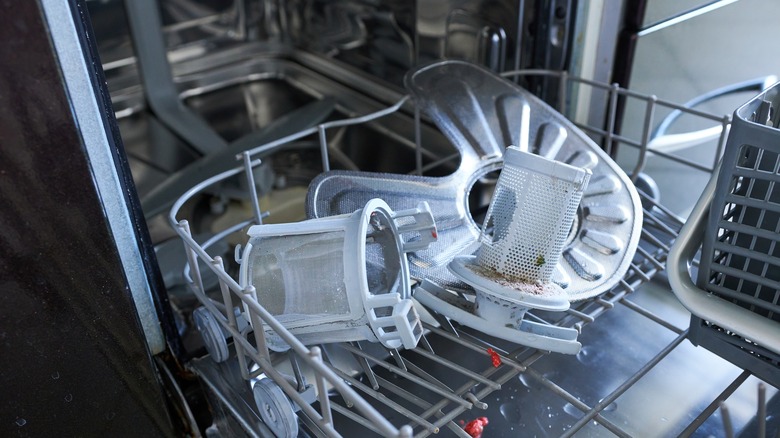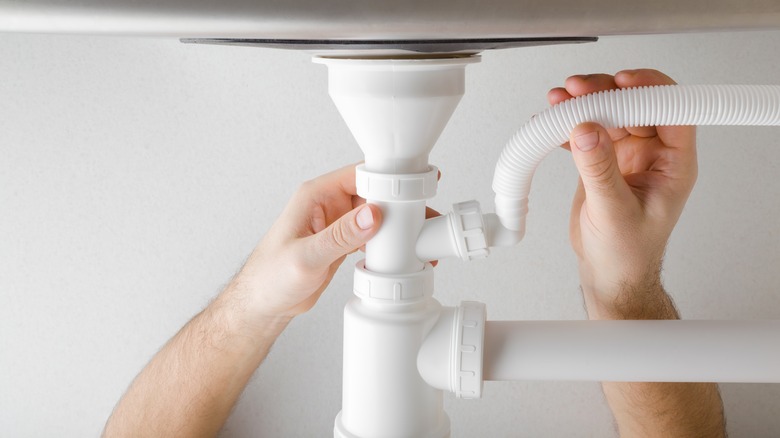Why There's Standing Water In Your Dishwasher & How To Fix It
Are you finding standing water in the dishwasher every time you open it after a cycle? If so, we have some good news, and possibly some bad news. The good news is, in most cases, standing water in the dishwasher is the result of a clog that's occurred as food scraps have accumulated in the system over time. Now, the bad news: If the standing water is not the result of a clog, you may have to splurge on the help of a professional to diagnose and replace a faulty part inside the dishwasher.
Dishwasher clogs happen because little bits of food, or any other debris that finds its way into the device, build up around the machine's filter. The filter's mesh is designed specifically to trap these particles and prevent them from going down the drain. If you don't clean the dishwasher properly and frequently enough, the filter mesh will have so much debris caked on to it that water will simply have no way out to the drain hose. Cleaning this filter should resolve the malfunction. On the other hand, clogs can also occur inside the drain hose, which is also easy enough to detach, snake, and reattach — even if you're a novice to this type of repair. To make your job easier, below we outline the steps for troubleshooting a dishwasher that's not draining water properly.
How to unclog and clean a dishwasher filter
Most modern dishwashers have removable filters, which are usually located at the bottom of the tub, under the lower rack. To find this filter, slide the lower rack out and remove it from the rails. If the filter is concealed by a mesh panel, remove the panel by hand. Then, look for a tube with mesh sides — that's the filter. Some models let you pull the filter out by sliding it upwards; with others, you may have to rotate the tube to unscrew it from the tub.
Once you have the filter out, check if it's accumulated food scraps; if it has, you now know why the water wasn't draining from the dishwasher. The next step is to clean the dishwasher filter thoroughly. Hold the filter under running water in the sink, and use a sponge to carefully wipe debris from the mesh. If the gunk is stuck and the sponge isn't able to cut through it, use a soft-bristle brush (a toothbrush will work well) to clean the filter. While you're at it, give the mesh panel that conceals the filter a gentle cleaning, too. When you're done, put the parts back into the dishwasher in reverse order, and see if the water will drain next time you do your dishes. Now, some dishwashers come with integral, self-cleaning filters. In this case, the clog may be caused by another issue.
Other issues that may cause a clogged dishwasher
If cleaning the filter does not eliminate standing water in your dishwasher, you may have two potential problems on your hands. For one, the drain hose itself may be clogged. This hose connects your dishwasher to the drain under the sink, and if scraps of food create a clog inside it, water will not be able to drain from the dishwasher. To check if a clogged drain hose is the source of your problems, disconnect it from the dishwasher at its point of connection to the drain, following the manufacturer's instructions. With the hose detached, try cleaning it with a drain snake. If the snake pulls out debris, then you've found the culprit and can safely reattach the hose following the user manual.
If the procedure we described above doesn't reveal a clog inside the hose, the standing water mystery deepens a bit. Unfortunately, the next most likely cause of the drainage problems is the drain motor inside the dishwasher. This motor is responsible for expelling dirty water out of the machine via the hose, and if it breaks, the water will accumulate inside the tub. The absence of a clog in the filter or drain hose, along with the presence of standing water in the dishwasher, suggests that the drain motor is broken. It could also be a sign that the dishwasher is getting old. You'll need to call a professional to diagnose the issue and perform repairs.


